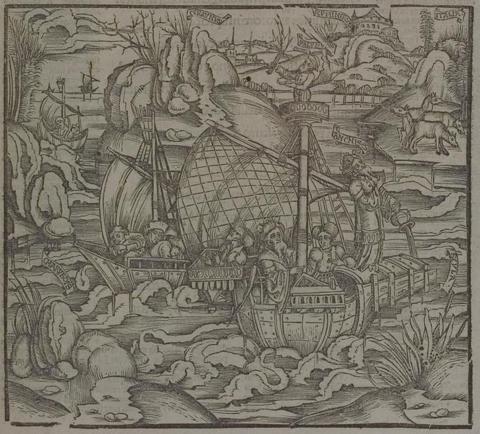Annotations
The ship of Aeneas has sailed past the Ceraunian mountains (506-7). Italy is in the top right corner (521-5). Palinurus, helmsman of Aeneas, stands in the crows nest, and rouses the sailors to rowing. Anchises, standing on the stern of the ship, pours an offering of wine into the sea (525-7). Far up on the shore stands the Temple of Minerva, a sign that they are near the shore of Calabria (Page 1967, 312 ad III 531). On the shore are four animals that are supposed to be white horses (537-8), which Anchises interprets as a sign of both war and peace (539-43). In the lower corners, Scylla and Charybdis, islands full of craggy rocks, are shown (551-560). The ships are about to face the dreaded Charybdis, which happens in lines 558-69. (Katy Purington)
Woodcut illustration from the “Strasbourg Vergil,” edited by Sebastian Brant: Publii Virgilii Maronis Opera cum quinque vulgatis commentariis expolitissimisque figuris atque imaginibus nuper per Sebastianum Brant superadditis (Strasbourg: Johannis Grieninger, 1502), fol. 201r, executed by an anonymous engraver under the direction of Brant.


Sebastian Brant (1458–1521) was a humanist scholar of many competencies. Trained in classics and law at the University of Basel, Brant later lectured in jurisprudence there and practiced law in his native city of Strasbourg. While his satirical poem Das Narrenschiff won him considerable standing as a writer, his role in the transmission of Virgil to the Renaissance was at least as important. In 1502 he and Strasbourg printer Johannes Grüninger produced a major edition of Virgil’s works, along with Donatus’ Life and the commentaries of Servius, Landino, and Calderini, with more than two hundred woodcut illustrations. (Annabel Patterson)